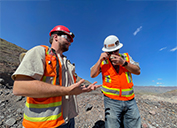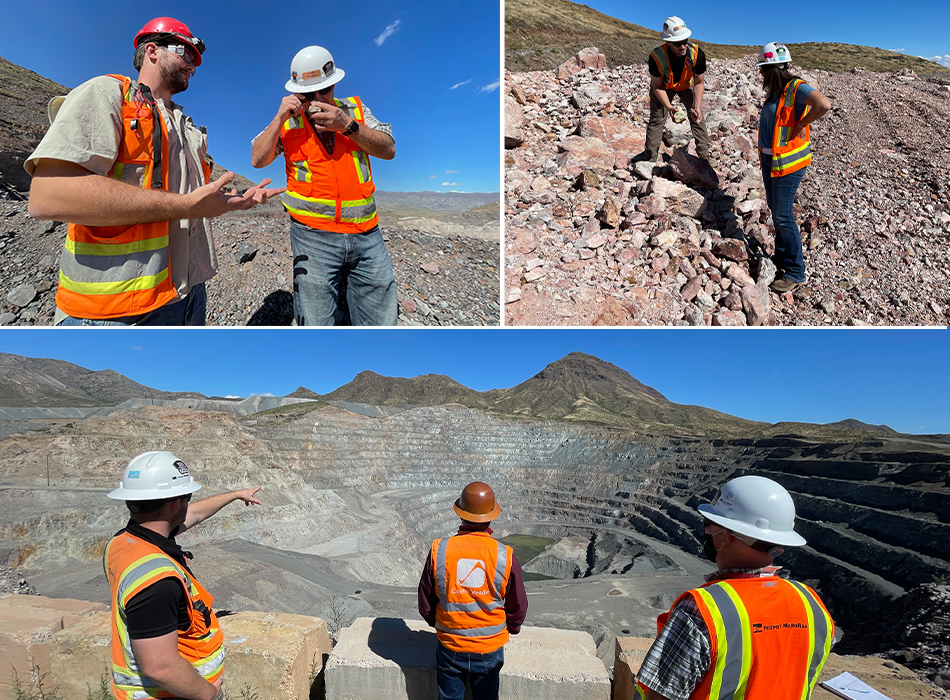Safford Employees Gain Understanding of Site Geology

January 7, 2022 – Safford, Ariz., employees are learning about the ground that supports their jobs.
Last summer, the Safford Geology team began hosting tours of the site’s three open pits – Dos Pobres, San Juan and Lone Star – to provide employees a crash course on the rock, soil and other geologic layers that contain and surround Safford’s copper deposits.
“The idea for the tour came up in a department meeting,” said Ryan Helms, who led a recent tour with fellow Safford Geologist Lou Shanley. “We realized that the ideal introduction to our world would be a trip into the field, which is more engaging and impactful than a PowerPoint.”
Twice a month, employees are transported to safe viewing locations at the pits, where Geology team members share expert knowledge about the visible layers in the pit walls and the geologic events in the distant past that created them. The tour connects the dots between detailed, up-to-date geology intel and the particulars of how Safford mines, crushes and leaches ore for mineral recovery.
“It’s a great communication tool for helping those outside our discipline better understand the work we do and how it influences the decisions and actions driving the work they do,” Shanley said.
Windows into the past
An illustrated tour handout shows Safford’s mineralized zones distributed along faults separating different rock formations, each a remnant of a particular segment in the region’s geologic history. The currently inactive Dos Pobres pit, for example, is cut almost exactly in half from northwest to southeast by the Butte Fault, which divides Dos Pobres like a time wall.
“One half of Dos Pobres dates back about 60 million years,” Helms said. “The other half dates back about 20 million years.”
The geologists noted that much of the Safford mining district lies in a prehistoric volcanic zone, as evidenced by compacted volcanic ash throughout Safford’s excavated terrain and exposed lava tubes in Lone Star’s pit walls.
“Some of the hardest material we’ve found at Safford comes from an ancient volcanic vent complex in Lone Star,” Helms said.
The handout explains Safford’s layers as having formed during the solidification of molten lava from different volcanic events over the last 80 million years. Those layers are rock types known by geologists to coincide with the presence of significant mineralization, particularly copper. In Lone Star, the layers are on vivid display.
“All the different levels of mineralization visible in the Lone Star pit are fascinating,” said James Bell, Senior Technical Instructor and tour participant. “Having come from the Morenci mine, I never saw anything there that showed it that clearly.”
Pit life beyond oxide
Their levels of mineralization are why the pits exist. Early exploration in what now is the Lone Star pit identified underground faults and dikes containing deep deposits of oxidized, copper-rich material – a major selling point for the development of Lone Star. Similar conditions made Lone Star’s predecessors – Dos Pobres and San Juan – attractive targets, and even though neither pit is active at present, each remains a place to Pursue Value.
“Most of the leachable oxide ore in Dos Pobres was mined out by 2016, and most of San Juan’s was depleted by late 2020,” Helms said, “but, like Lone Star, those areas also contain deep pockets of sulfide material, which could be suitable for any milling Safford might do in the future.”
Dos Pobres has an additional distinction.
“Unlike San Juan’s and Lone Star’s sulfide deposits, which contain copper and molybdenum, the sulfide in Dos Pobres contains copper and gold,” Helms said, “so it will be interesting to see how that pit figures into Safford’s future.”
Geology’s influence extends to safety
As mining expands at Safford, information that geologists and the lab glean from blast hole drill samples can be used by other site teams to develop and execute mine plans, manage different ore grades and optimize copper recovery, among other things.
“At this stage of mining in Lone Star, sample data is critical for properly blending crushed ore to manage clay content and preserve leach pad permeability,” Helms said.
The data also supports a more important function of ore blending – protecting employees working on the leach pad.
“Some ore contains calcite, which reacts with the acid in leaching solution and produces carbon dioxide,” Helms said. “Because CO₂ is heavier than air, it can concentrate on the leach pad surface, so the sample data is vital for carefully blending ore to control calcite levels.”
Less obvious geology connections
For many support teams and others not directly involved in production activity, the link between geology and their roles is largely obscured. The tour serves to illuminate that link.
“I focus on the numbers side of the business, so getting out into the field helps complete the picture the numbers provide,” said tour participant Will Banks, Accountant II-Safford. “It’s great insight into pit development, and it furthered my understanding of how the mine plan is adjusted based on what geology is able to find.”
One recent geology finding is that the tour is a hit among fellow Safford employees like Banks.
“Initial interest and participation have been good,” Helms said. “As the busy fourth quarter and holidays approached, we ended our first schedule in fall, but we’ll be ready to resume the tours in early 2022.”

Photos (clockwise): Safford Geologist Lou Shanley (left) describes the mineralogy of a rock sample being closely examined by tour participant Jason Phillips during a stop at the Lone Star pit; Safford Geologist Ryan Helms (left) explains rock sample differences to tour participant Stephanie Bryce; Safford Geologist Ryan Helms (left) points to features in the Dos Pobres pit as he speaks to geology tour participants.



 BACK
BACK
SOCIAL
RECOGNITION